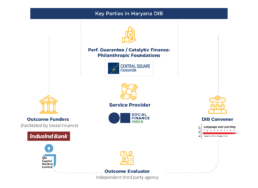India has made significant gains towards providing access to education. However, it is currently facing an unprecedented learning crisis. Most Indian children perform below grade- level in both literacy and numeracy, which leads to reduced life chances and poor employment opportunities.

of children in Grade 2 cannot
read a single word of a short text.
Only a quarter of all children in Grade 3
can read at grade-level.

of children enrolling in Grade 1
in India graduate from Grade 12.
Poor foundational learning drives student learning
levels to flat line in secondary school, and the
widening learning deficit is at an unprecedented high

A weak education has far-reaching consequences on the child’s income and life, as well as on the country, with quality education underpinning the achievement of most other Sustainable Development Goals.
In 2019-20, SF-India launched a first of its kind risk guarantee model with CSR as outcome payor. It leverages philanthropic funds by ~5x to supersize impact and reach. The goal is to increase foundational learning in India.
Designing the Solution:
- Piloting the first of its kind CSR fund bond in India
- Social Finance India (SF India) has convened an impact bond to scale up the existing program of Language and Learning Foundation in India in the state of Haryana.
- The DIB will cover all government schools in 7 districts over three years (July 2019 to June 2022), supporting improved literacy outcomes
- The DIB (which is currently in its first phase of implementation) will positively impact foundational literacy outcomes for 115,000 children across 3,300 schools in Haryana
- It aims to systematically strengthen the capacities of the teachers and teacher educators to improve student outcomes in early grade language skills, that can subsequently be replicated by the government across the state.
Outcome expected from at the end of the DIB (Grade 2 students):
| Read fluently | Understand appropriate texts as well as write simple sentences | Are confident to express their experiences, reasoning and thoughts |
|---|
These outcomes are in alignment with Haryana’s state learning outcomes and NCERT learning outcomes and will be enumerated further.

HOW THE MODEL WORKS FOR
MOBILIZING CSR FOR OUTCOMES PAYMENT
- Performance Guarantor underwrites the outcomes achieved by the Service Provider
- CSR Foundations in India pay upfront working capital to the Service Provider
- Service Provider delivers the intervention and Independent Evaluator measures the Outcomes
- If pre-agreed Outcomes are underachieved, Performance Guarantor gives Grant to another program funded by CSR Foundation to the extent of shortfall in outcomes
- If pre-agreed Outcomes are met or overachieved, Performance Guarantors do not pay anything
Stakeholders and Roles
Outcome Funder
(Domestic CSR)
01
Performance Guarantor
(Philanthropy)
02
DIB Convener
(Social Finance India)
- Designs and structures the DIB, and identifies DIB anchors
- Facilitates outcomes fundraising from CSR and risk guarantee from philanthropy
- Selects the outcome evaluator
- Performance management
03
Ed. TECH SOLUTIONS FOR
MARGINALISED POPULATIONS
Ed. TECH SOLUTIONS FOR
MARGINALISED POPULATIONS
While India has made extensive headway in terms of enrolment and access, we still lag behind in:
- Foundational literacy outcomes (24% of children aged 0-8 do not receive an early childhood education)
- Basic competencies and teacher training (50% of Grade 5 students cannot read a Grade 2 text)
- Ed. Tech Integration in rural & government schools
What is the challenge?
01
Rural govt. schools in backward communities and economically backward regions are lacking in resources (Covid-19 has highlighted the systemic gaps on account of schools not having the potential to go ‘online’ thus leading to large scale learning gains erosion)
02
Within a single grade, there are wide variations in student learning levels and aptitudes. This makes it impossible for teachers to tailor their delivery for each student, under traditional education pedagogy and bring them up to grade level. (A typical student in India is two grades behind the level expected for their age in literacy and numeracy)
03
Marginalized Populations face additional hurdles in terms of teachers not having adequate teaching prowess in remedial learning . As a result, low-performing students are permanently left behind and drop out as they do not receive the academic support they need.
Designing The Solution
One prospective solution Social Finance has envisioned is the scaling of Personalized Adaptive Learning (PAL) through a Pay for Success Construct:
- EdTech based Personalized Adaptive Learning (PAL) can help low-achieving students catch up and reach age-appropriate learning ability. Recent assessments have demonstrated gains in learning outcomes as high as 2-2.5X through specific PAL solutions.
- By supplementing school infrastructure and educating teachers on effective pedagogy, EdTech solutions can help schools use PAL to deal with remedial learning while simultaneously strengthening a student’s capacity to learn and retain
- A strong data management capability is built out providing real time progress on student performance through monitoring dashboards helping effectively improve student’s language and learning capabilities.
Value Proposition of Scaling Ed. Tech based PAL Solutions?
- We are exploring building a program for scaling a personalized adaptive EdTech solution in partnership with our service provider partner for Tribal schools
- In the long run, scaling this specific solution through a Pay for Success Construct will help showcase the effectiveness of EdTech integration into rural government schools to improve learning outcomes
